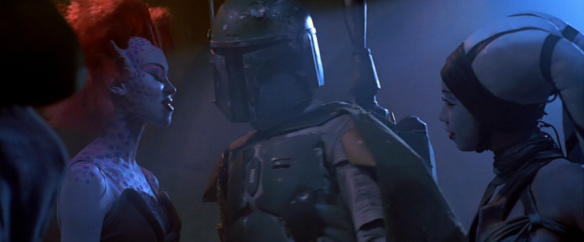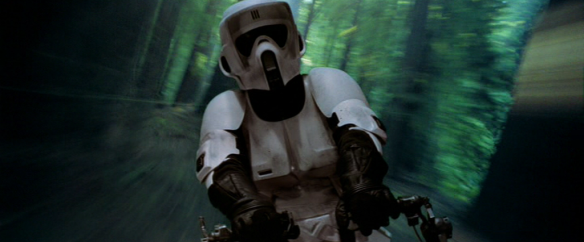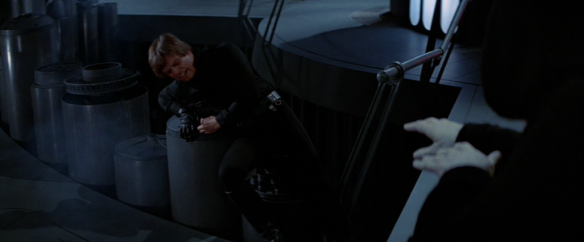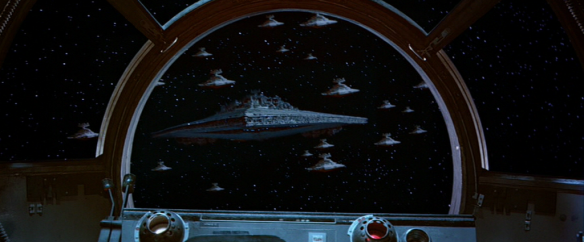 See also:
See also:
- Star Wars Randomised
- Star Wars: The Empire Strikes Back Randomised
- Star Wars: Return of the Jedi Randomised
- Star Wars: The Phantom Menace Randomised
- Star Wars: Attack of the Clones Randomised
- Star Wars: Revenge of the Sith Randomised
The last in the “original trilogy” of films is ready to be Randomised, reduced to three randomly selected frames, which will then provide a basis for my discussion of “random” aspects of the film (as opposed to the usual tactic of picking out the stuff that suits my own thesis).
I remember Return of the Jedi better than any other Star Wars film. Iwas the right age when it came out – old enough to understand the plot and to have some investment in the lives of its characters, but young enough that the inclusion of a tribe of cheeky teddy bears seemed like a crazy-funny idea to pep up an increasingly downbeat and self-important franchise with some unselfconscious slapstick rather than a canny-cunning concession to the toy market. This is the first time I remember being, like, totally psyched (as I believe young people are saying these days) for an upcoming film. I even read an article in Time magazine, an unusual activity for this particular 8 year-old, which I remember being a million pages long and published months before the film came out; actually it was published in the week of the film’s release: it just felt like ages before I would get to see the film for myself. I also suspect that this film, in a pincer movement with The Muppet Show, cemented a lifelong interest in puppets. The accompanying documentary, Classic Creatures, confirmed that George Lucas’s galaxy was one where humans were interlopers in a crowd of rubbery creatures.
Anyway, enough nostalgia. The randomiser has given me the following numbers: 15, 59, 97 and 110. A very good spread, I think. Let’s see what we get:
 15 minutes in, we’re at the court of Jabba the Hutt, a giant slug-thing as capriciously sultanic as a Charles Laughton performance. This is a shot that has been added for the Special Edition re-release of 1997. The two humanoid girls are dancers from the house band (their parts were added when George Lucas decided to expand the group’s musical number to a full-blown muppet-fest), Rystáll Sant (left) and Lyn Me (right). Bounty hunter Boba Fett, through the addition of this one shot (actually, I think there are two glimpses of the master shot of this group), is transformed into a suave ladies man, instead of the skulking dude in the corner too shy to take his suit off even in the desert. In the prequels, he is given a backstory that posits him as the donor DNA for the Clone army, and his uniform now looks like an antique version of their suits. His trajectory in those films had obviously not been planned at the time of Return of the Jedi in 1983, because he is given a throwaway slapstick death scene to match his minimal screentime. But fans had taken the character to their hearts, surely on the basis of his cool outfit; it’s not like he does very much in the films themselves, and it can’t be entirely because of his earlier cartoon appearance in the Star Wars Holiday Special, an utterly execrable embarrassment about some kind of Wookiee Christmas, as far as I recall. Anyway, the nightclub backlighting and alien groupies pay him the respect that his followers clearly believed he was due. The dancers are marked as exotic, with their colourful skin and hair, and their slightly augmented anatomy. At least as far back as the Star Trek Green Lady, lovelorn and pent-up fanboys have been prompted to imagine whether alien women were different in all kinds of ways, and Star Wars has a lot of catching up to do in the sex department, devoid as it is of even implicit eroticism beyond a bit of (tom)boyish flirting here and there. It’s just a shame that, in trying to loosen up the Lucas libido, the film ends up dressing girls in fetish wear instead of giving them something interesting to say or do.
15 minutes in, we’re at the court of Jabba the Hutt, a giant slug-thing as capriciously sultanic as a Charles Laughton performance. This is a shot that has been added for the Special Edition re-release of 1997. The two humanoid girls are dancers from the house band (their parts were added when George Lucas decided to expand the group’s musical number to a full-blown muppet-fest), Rystáll Sant (left) and Lyn Me (right). Bounty hunter Boba Fett, through the addition of this one shot (actually, I think there are two glimpses of the master shot of this group), is transformed into a suave ladies man, instead of the skulking dude in the corner too shy to take his suit off even in the desert. In the prequels, he is given a backstory that posits him as the donor DNA for the Clone army, and his uniform now looks like an antique version of their suits. His trajectory in those films had obviously not been planned at the time of Return of the Jedi in 1983, because he is given a throwaway slapstick death scene to match his minimal screentime. But fans had taken the character to their hearts, surely on the basis of his cool outfit; it’s not like he does very much in the films themselves, and it can’t be entirely because of his earlier cartoon appearance in the Star Wars Holiday Special, an utterly execrable embarrassment about some kind of Wookiee Christmas, as far as I recall. Anyway, the nightclub backlighting and alien groupies pay him the respect that his followers clearly believed he was due. The dancers are marked as exotic, with their colourful skin and hair, and their slightly augmented anatomy. At least as far back as the Star Trek Green Lady, lovelorn and pent-up fanboys have been prompted to imagine whether alien women were different in all kinds of ways, and Star Wars has a lot of catching up to do in the sex department, devoid as it is of even implicit eroticism beyond a bit of (tom)boyish flirting here and there. It’s just a shame that, in trying to loosen up the Lucas libido, the film ends up dressing girls in fetish wear instead of giving them something interesting to say or do.
 A little later, at the film’s halfway point, we have an exhilarating chase on the literally named speeder bikes through the forests of Endor. It’s all forests on Endor. The motion blur on the scenery, accentuated by the sharp focus on the biker scout (used to be one of the favourites in my collection of action figures), demonstrate the incredible pace of this sequence. A self-confessed boy racer in his youth (see American Graffiti for evidence of a nostalgia for shiny, shiny cars), George Lucas finds plenty of chances in his Star Wars franchise for chase sequences and vehicular combat, all of them built on his signature coupling of mortal danger and a gleeful enjoyment of speed. So many complex special effects went into this sequence, including travelling mattes, miniatures and live action footage of the actors. But it hinges on a very simple trick – some dude with a camera has to walk through the forest, capturing the background footage that will then be played back at high speed. There are plenty of contests between vehicles in the Star Wars universe, so it’s refreshing to see one so close to the earth. Endor is one of the staging posts for the final battle between the Empire and the Rebels, marking out most forcefully the clash of interests between a hyper-technologised ruling party and the traditional cultures that populate its colonies.
A little later, at the film’s halfway point, we have an exhilarating chase on the literally named speeder bikes through the forests of Endor. It’s all forests on Endor. The motion blur on the scenery, accentuated by the sharp focus on the biker scout (used to be one of the favourites in my collection of action figures), demonstrate the incredible pace of this sequence. A self-confessed boy racer in his youth (see American Graffiti for evidence of a nostalgia for shiny, shiny cars), George Lucas finds plenty of chances in his Star Wars franchise for chase sequences and vehicular combat, all of them built on his signature coupling of mortal danger and a gleeful enjoyment of speed. So many complex special effects went into this sequence, including travelling mattes, miniatures and live action footage of the actors. But it hinges on a very simple trick – some dude with a camera has to walk through the forest, capturing the background footage that will then be played back at high speed. There are plenty of contests between vehicles in the Star Wars universe, so it’s refreshing to see one so close to the earth. Endor is one of the staging posts for the final battle between the Empire and the Rebels, marking out most forcefully the clash of interests between a hyper-technologised ruling party and the traditional cultures that populate its colonies.
 An an unenlightened child, it always puzzled me why these mighty, wise warriors, good or evil, didn’t just kill each other. Instead they brandish statements like “give into your hatred” or “if you strike me down I shall become more powerful than you can possibly imagine”. Really? Do they want to be killed or not? What happened to the old ways of goodies and baddies trying to kill each other because each represented a threat to the other’s plans? And why did Darth Vader kill Obi-Wan Kenobi if he knew it would make him more powerful? Only later did I understand that the plan was to turn Luke Skywalker into an asset of evil and turn him to the Dark Side. This might seem like a spiritual conception of evil as a corrupting infection that requires a single transgressive act (tellingly centred around the killing of a feared enemy) to let the infection take over the body and mind, but it’s also a conservative one where you either are or are not wicked and get branded as such. In any case, by the end we still wind up with the Emperor preparing to kill Luke once and for all. The camera moves with him, his hands threatening inwards from the side of the frame, an over-the-shoulder, almost-point-of-view shot signalling the pushing of the young Jedi towards the edge of the precipice. Think how many important showdowns or daring escapes happen on the edge of these apocalyptic canyons in George Lucas’ adventure serials (i.e. including the Indiana Jones films). Nothing signifies imminent doom better than a potential plummeting towards a vanishing point. These dangers of extreme vertical drops stand in sharp contrast to the horizontal axes of the chase scenes such as the one in the previous frame. Death comes when the forward motion stops.
An an unenlightened child, it always puzzled me why these mighty, wise warriors, good or evil, didn’t just kill each other. Instead they brandish statements like “give into your hatred” or “if you strike me down I shall become more powerful than you can possibly imagine”. Really? Do they want to be killed or not? What happened to the old ways of goodies and baddies trying to kill each other because each represented a threat to the other’s plans? And why did Darth Vader kill Obi-Wan Kenobi if he knew it would make him more powerful? Only later did I understand that the plan was to turn Luke Skywalker into an asset of evil and turn him to the Dark Side. This might seem like a spiritual conception of evil as a corrupting infection that requires a single transgressive act (tellingly centred around the killing of a feared enemy) to let the infection take over the body and mind, but it’s also a conservative one where you either are or are not wicked and get branded as such. In any case, by the end we still wind up with the Emperor preparing to kill Luke once and for all. The camera moves with him, his hands threatening inwards from the side of the frame, an over-the-shoulder, almost-point-of-view shot signalling the pushing of the young Jedi towards the edge of the precipice. Think how many important showdowns or daring escapes happen on the edge of these apocalyptic canyons in George Lucas’ adventure serials (i.e. including the Indiana Jones films). Nothing signifies imminent doom better than a potential plummeting towards a vanishing point. These dangers of extreme vertical drops stand in sharp contrast to the horizontal axes of the chase scenes such as the one in the previous frame. Death comes when the forward motion stops.
Finally: this one is for you, readers – the bonus frame. The 97th minute. Take a deep breath, flex your typing fingers and tell me what you can say about this:


Dan, as ever an interesting blog post.
The bonus shot – from the confines of the Millennium Falcon out into the vast breadth of space, and in between the ominous Star Destroyers and Super Star Destroyer. Seeing this on the big screen you get a sense of why Lucas’ original trilogy works – it’s all about spectacular scale, and the importance of visual effects for the producer/director. But furthermore, it highlights (even if we were ever in any doubt) the increasing value Lucas placed upon them. By the time we get to Episodes I – III its all about the visual effects, with the films becoming awash with fast paced, flashy and largely video-game styled visuals. What’s great about this shot, much of the effects that surround it, and indeed the original trilogy of films is an additional sense of weight and almost ponderous speed used. Something that reflects (I believe) the more character and – dare I say it – ‘classical’ narrative bent of the earlier trilogy of films. In seeing the Star Destroyers just hanging, apparently unmoving you are reminded of the very first Star Wars, and its opening moment when the Rebel Blockade Runner and the chasing Imperial cruiser slowly lumber overhead and then keep going, and going. And the final minutes where the Death Star takes an age to get into position.
Instead of racing through much of the post Jedi films imagery this shot allows us to see what’s happening, think and engage with the content. Too often in the later films the action is fast, fast, fast with zipping craft and CG effects that are pixels on amphetamines. It’s highly prescient, showing in its contents not just a sense danger and possible doom for the Rebels, but perhaps also the foreboding of Star Wars films (and Lucas ideals) to come?
Thanks, Paul – I really like the point about the stolid Imperial ships. They have the privilege of slow movement, bringing with it a strict, machinic regulation of space and movement; it’s a good shorthand for their colonisation of the galaxy (the effects of which we never actually get to see). This may be why Lucas reserves all kinds of erratic slapstick movement for the Rebellion and its allies – the counterpoints to the Empire are, unfortunately, furry things like the Ewoks and clumsy amphibious dorks like Jar Jar Binks, all of which seem to be in constant motion.
Pingback: Ladakh Tours- the best trekking destination | Language And Travel News
Pingback: Star Wars: Attack of the Clones Randomised « Spectacular Attractions
Pingback: Star Wars Randomised « Spectacular Attractions